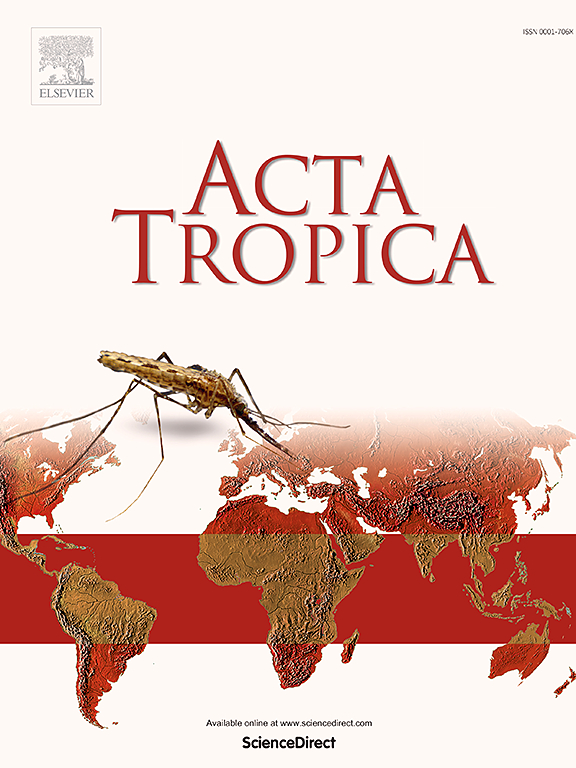以 "一体健康 "方法了解哥伦比亚安第斯山脉哺乳动物、蜱虫和立克次体之间的相互作用。
IF 2.1
3区 医学
Q2 PARASITOLOGY
引用次数: 0
摘要
传染病,尤其是人畜共患传染病,对人类和动物的健康都构成了重大的全球性威胁。蜱虫是影响野生和家养动物的病原体的主要传播媒介之一,其中一些病原体还可导致严重的人类疾病。为了有效应对人畜共患病,目前正在推广 "统一健康 "方法,以整合人类、动物和生态系统的健康。在这里,我们确定了哥伦比亚安第斯地区蜱虫、立克次体、野生和家养哺乳动物以及人类之间的关联。我们共采集了属于 Amblyomma、Dermacentor、Ixodes、Ornithodoros 和 Rhipicephalus 属的 17 个种类的 366 只蜱虫,这些蜱虫有的自由生活,有的寄生于人类、野生动物(22 种)和家养哺乳动物(3 种)。在分析的蜱虫中,3.4%(n = 3)检测到感染了 Parkeri NOD 株立克次体、cf. monacensis 立克次体和 "Tarasevichiae 立克次体"。这项研究强调了蜱虫在哥伦比亚人类、野生和家养哺乳动物中的多样性。它还强调了这些体外寄生虫对人类和动物健康造成的风险,因为它们有可能传播立克次体等人畜共患病原体。本文章由计算机程序翻译,如有差异,请以英文原文为准。
A “One health” approach to the understanding of mammals, ticks and Rickettsia interactions in the Andes of Colombia
Infectious diseases, especially zoonotic, represent a significant global threat to both human and animal health. Ticks are among the primary vectors of pathogens affecting wild and domestic animals, some of which can also cause severe human diseases. To effectively face zoonotic diseases, the "One Health" approach is being promoted to integrate the health of human, animals, and ecosystems. Here, we identify the associations between ticks, rickettsiae, wild and domestic mammals, and humans in the Andean region of Colombia. A total of 366 ticks of 17 species belonging to the genera Amblyomma, Dermacentor, Ixodes, Ornithodoros, and Rhipicephalus were collected as free-living organisms, or parasitizing humans, wild (22 species) and domestic (3 species) mammals. Infection with Rickettsia parkeri strain NOD, Rickettsia cf. monacensis and ‘Candidatus Rickettsia tarasevichiae’ was detected in 3.4% of the ticks analyzed (n = 3). This study highlights the diversity of ticks in humans and wild and domestic mammals in Colombia. It also underscores the risk these ectoparasites represent to human and animal health due to the potential transmission of zoonotic pathogens such as Rickettsia spp.
求助全文
通过发布文献求助,成功后即可免费获取论文全文。
去求助
来源期刊

Acta tropica
医学-寄生虫学
CiteScore
5.40
自引率
11.10%
发文量
383
审稿时长
37 days
期刊介绍:
Acta Tropica, is an international journal on infectious diseases that covers public health sciences and biomedical research with particular emphasis on topics relevant to human and animal health in the tropics and the subtropics.
 求助内容:
求助内容: 应助结果提醒方式:
应助结果提醒方式:


